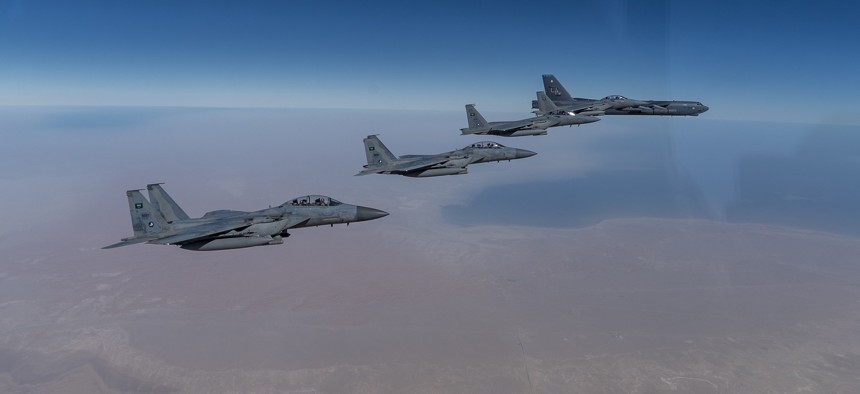
U.S. Air Force B-52 Stratofortress' take off from Barksdale Air Force Base, LA, during a bomber task force mission over the U.S. Central Command area of responsibility, Jan. 26, 2021. U.S. Air Force photo by 2nd Bomb Wing Public Affairs
US Flies B-52 Bomber To Gulf In Show of Force Against Iran
“We were also thinking…'Would they try to test the U.S. military in the early days of the new administration?'”
AL UDEID AIR FORCE BASE, Qatar — An American B-52 bomber flew to the Persian Gulf and back to the United States on Tuesday as a show-of-force intended to reassure allies and deter Iranian aggression in the region during the delicate moment of a U.S. presidential transition.
The deployment is the fourth such mission in the last two months, and the first since President Joe Biden took office on Jan. 20, vowing a fresh approach to U.S. policy towards Iran.
“We do know that U.S. policy is evolving with respect to Iran right now and the new administration will make some decisions here over the next while,” said a U.S. military official. “I do know if we can continue to deter Iranian aggression… that it’ll give the policymakers more decision space.”
The official said that the timing of the exercise wasn’t linked to any particular incident or threat — such missions are pre-planned weeks in advance, that person said — but it comes amid a series of back-to-back explosions in Riyadh, at least one of which appears to have been an intercepted attack on the Saudi palace.
Instead, “The timing was determined based on the value of deterrence after inauguration,” the official said, noting that the military has been on a heightened state of alert for months surrounding the November election, Biden’s inauguration and the one-year anniversary of the U.S. killing of top Iranian general Qassem Soleimani.
“Other concerns included: would they try to do something to get some revenge on the Trump administration as they left office?” the official said. “We were also thinking ahead and going, ‘Okay, would they potentially try to test or pressure the U.S. military in the early days of the new administration?'”
Two other similar flights took place on Jan. 8 and Jan. 17, just days before Biden's inauguration.
So far, military officials believe they have successfully deterred Iran and its proxies from launching any serious attacks on U.S. forces or its interests in the region.
“Our assessment right now is Iran is probably not going to do anything to provoke the United States right now,” the official said. “They seem to be biding their time, waiting to see what the new administration’s policy is toward them.”
The two B-52s left from from the 2nd Bomb Wing's home at Barksdale Air Force Base, in Louisiana, flew across Jordan and Saudi Arabia, then dipped into the Persian Gulf itself near Qatar before returning home. They were joined at various points by Jordanian and Saudi fighter jets, as well as U.S. fighters from the aircraft carrier USS Nimitz.
Known as a “Stratofortress,” the B-52 is a long-range heavy bomber dating from the earliest days of the Cold War that still serves as one of the military’s work horses. It is able to fly for more than 8,800 miles without being refueled.
The military has more of these bomber missions planned later in the spring, the military official said, although none will take place in the “next several weeks," the official said.
"The United States does not seek conflict, but continues to be postured and committed to respond to any contingency around the world," U.S. Central Command said in an unattributed statement.




